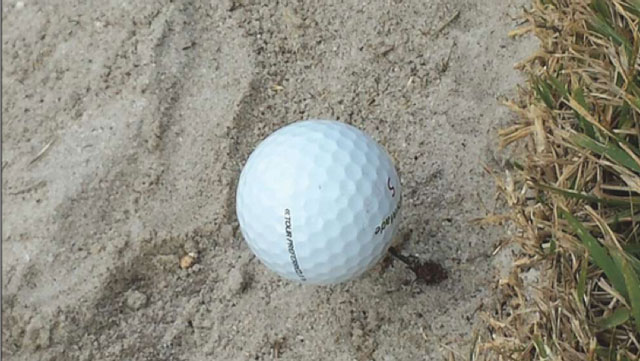NEWS
Impaled ball, bunker fire ants lead to bizarre rules situation

Editor's Note: This story originally appeared in the January edition of PGA Magazine.
I encountered a truly unique Rules situation during the first round of Event No. 1 of the 2016 PGA Tournament Series presented by Golf Advisor.
I was called to a fairway bunker in the drive zone of the par-5 7th hole on PGA Golf Club’s Wanamaker Course. When I arrived, I found 2016 PGA Professional Champion Rich Berberian standing next to his ball, which was suspended above the sand in the bunker by a bunker liner staple. The ball was about one inch above the surface of the sand. Rich asked several questions, but I told him to tell me what had happened leading up to the current situation before we could resolve the issue.
Rich said that he had hit his drive into the lip of the steep bunker and the ball appeared to be lying in the bunker at a point just below the lip. He made a stroke at the ball, however the ball did not move despite the fact that the sand beneath the ball was removed. Rich discovered that his golf ball was impaled on the liner staple suspended above the bunker. His first question was whether he had to count the stroke, since his ball didn’t move due to the obstruction. My answer was yes – he made a swing at the ball with the intent of hitting it, which is by definition a stroke.
“So what do I do now?” was his logical next question.
I then had to determine what Rule(s) were needed to resolve the situation. We had a ball impaled upon a movable obstruction in a bunker. Even though the definition of a bunker clarifies that the margin of a bunker extends vertically downward but not upward, Decision 13/5 states that a ball sitting on an obstruction in a bunker is in the bunker. With that being known, I was able to give Rich relief under Rule 24-2bii(a). This relief would allow Rich to lift the ball, remove the staple and drop the ball in the bunker as near as possible to the spot directly below where his ball was sus- pended above the bunker.
He now asked me another question: Do I have to play this ball? When proceeding under Rule 24-2 the answer normally is yes, unless the ball is not immediately recoverable, but in this case, we had a unique element. Rule 5-3 allows a player to replace a ball that becomes damaged in the normal course of play. Since his ball had been pierced by the staple and had been visibly cut, Rich was therefore allowed to substitute a new ball for the damaged original ball.
Then came his next question: “Can I rake out all the footprints that were made when I played my original stroke?” My answer was no, as Rule 13-2 prohibits a player from “improving” the area in which he is to drop a ball by “creating or eliminating irregularities of surface.” If a player worsens his lie, he must live with the worsened condition (Decision 13-2/29). If someone else had caused the dam- age without Rich’s direction, he would have been allowed to smooth that portion of the bunker that was damaged by the third party (Decision 13-4/10).
Rich then mentioned that after he had made his original stroke in the bunker, he noticed that the swing had uncovered an area of fire ants, which were now swarming. I told him that he was entitled to free relief from this dangerous situation under Decision 1-4/10.
This created a new set of circumstances that gave Rich an additional drop option. His drop under Rule 24-2bii(a) was probably going to result in his ball to coming to rest in his footprints. Since he was entitled to relief from the fire ants, we established his nearest point of relief that was no nearerthe hole and was still in the bunker. Rich was then allowed to measure one club length from that point with any club in his bag.
When this procedure was completed, he was able to drop the ball in a place that allowed it to roll down to the bottom of the bunker. Rule 20-2c(vi) requires a player to re-drop a ball if it rolls more than two club lengths from the spot it first strikes apart of the course, which it had. Rich retrieved his ball and redropped it, and it once again rolled more than two club lengths. So, as required by 20-2c(vi), Rich was allowed to place the ball on the spot where the second drop struck the sand in the bunker, which was still a much more level area than where his original ball lay.
I told Rich that his ball was in play, and thus ended this bizarre ruling.
Although obstructions, damaged golf balls, fire ants, drops and re-drops are common in officiating, the 300-yard drive impaled on a wire was a one-in-a- billion moment. You never know where a golf ball will end up, but the Rules of Golf are always ready.
